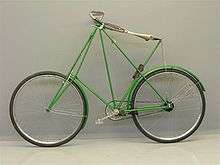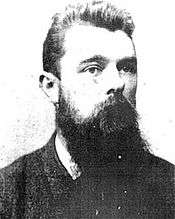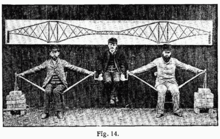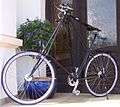Pedersen bicycle



The Pedersen bicycle, also called the Dursley Pedersen bicycle is a bicycle that was developed by Danish inventor Mikael Pedersen and produced in the English town of Dursley.[1][2] Though never hugely popular, they enjoy a devoted following and are still produced today.[3] Their unusual frame is described as pure cross,[4] was marketed as cantilever,[5] and features a distinctive hammock-style saddle. Variations include lightweight racing, tandem, and folding designs.[6][7] Other Pedersen innovations include two and three-speed internally geared rear hubs.[3]
History
Pedersen received a patent in the United Kingdom for his bicycle in the early 1890s and constructed the first model out of wood. He formed the Pedersen Cycle Frame Co. Ltd and when that fell into financial difficulties, production was continued by the Dursley Pedersen Cycle Co.[3] The design was also licensed to other manufacturers,[8] and approximately 30,000 units were produced by the early 1920s, but the design never really caught on. In 1978, Jesper Sølling resumed production in Copenhagen and has been followed by others.[9]
Technology
Pedersen wrote that he developed the hammock style seat first. It provides suspension from road imperfections with much less weight, 4 ounces (110 g) instead of 3 pounds (1.4 kg) of traditional leather and steel spring saddles of the day. Pedersen then developed a frame, a truss assembled from several thin tubes, around his new seat design. He attributed his inspiration to the Whipple-Murphy bridge truss. The design initially did not support seat height adjustment, and even after some adjustability was added, required the manufacture of eight different sizes. The non-standard frame design would not accommodate a traditional front fork. Instead, Pedersen developed a fork that also consisted of thin tubes assembled into a truss, which was attached to the frame with bearings at two distinct points, instead of through a traditional head tube. Pedersen also received patents for a chainwheel and bottom bracket combination and lightweight pedals.[2]
Gallery
 Modern Pedersen bicycle.
Modern Pedersen bicycle. Modern Pedersen bicycle.
Modern Pedersen bicycle. Modern Pedersen bicycle.
Modern Pedersen bicycle. Antique Pedersen on display
Antique Pedersen on display
References
- ↑ Herlihy, David V. (2004). Bicycle, The History. Yale University Press. pp. 288–289. ISBN 0-300-10418-9.
- 1 2 Mads Rasmussen. "Dursley Pedersen Cycles: History". Retrieved 2009-09-17.
- 1 2 3 "Dursley Glos Web: Mikael Pedersen and The Dursley Pedersen Cycle Company". Retrieved 2009-09-17.
- ↑ Jan van den Elshout and Herbert Kuner. "Cross Frames: Development of a special type of bicycle". Retrieved 2009-09-17.
- ↑ "Pedersen Bicycle: Static Theory". Retrieved 2009-09-17.
- ↑ "Pedersen bicycle: History". Retrieved 2009-09-17.
- ↑ "The Pedersen Bicycle, a brief History". Retrieved 2009-09-17.
- ↑ "The Star Cycle Company, Limited". Retrieved 2009-09-17.
- ↑ "The Pedersen". Retrieved 2009-09-17.
- Evans, David (1979). The Ingenious Mr Pedersen. A Sutton. ISBN 978-0-7509-0064-5.
- Town recalls pedal pioneer, Bristol Evening Post, 28 October 2005
- Town welcomes family of legendary inventor, Gazette Series, 28 October 2005
External links
| Wikimedia Commons has media related to Pedersen bicycles. |
- Pedersen Bicycle, Denmark.
- Pedersen Bicycles, US distributor.
- Dursley Pedersen Cycles
- Pedersen Manufaktur Kalkhoff GbR
- Mikael Pedersen and The Dursley Pedersen Cycle Company